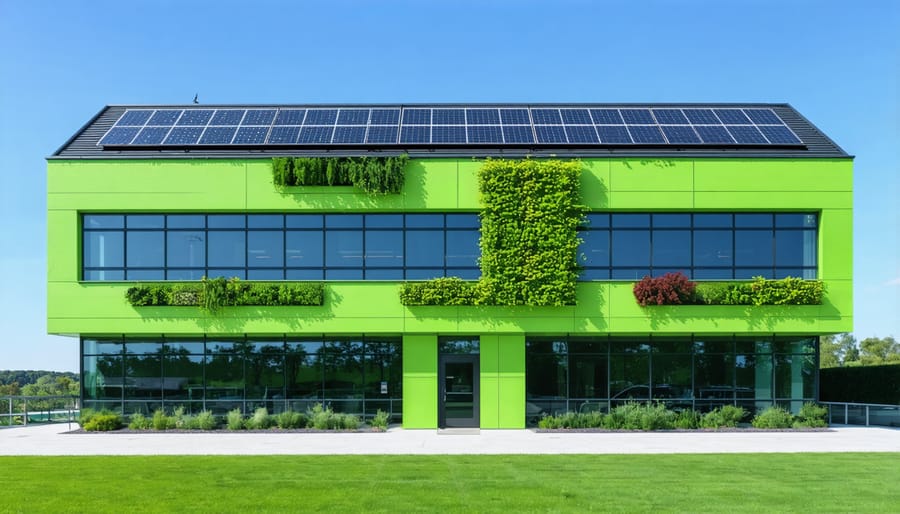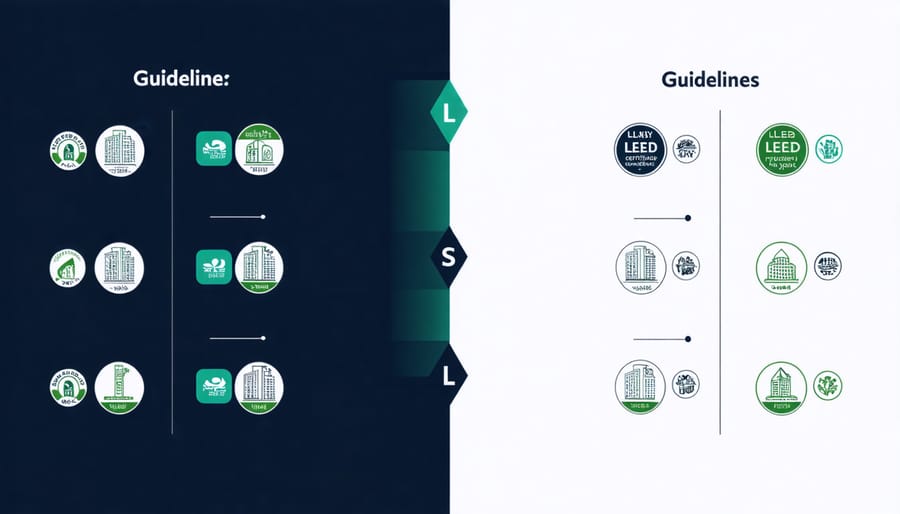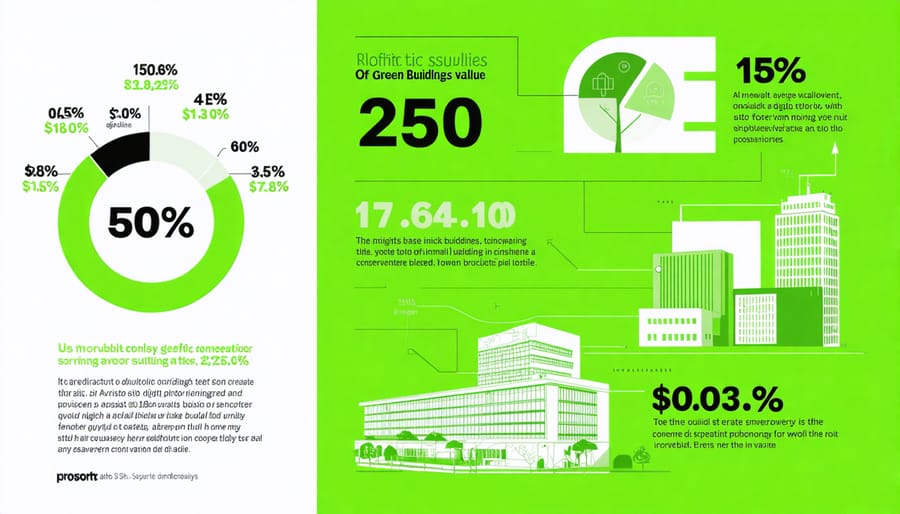In today’s climate-conscious construction landscape, green building certification stands as the gold standard for sustainable development and environmental responsibility. These third-party verification systems assess and recognize buildings that meet specific environmental performance criteria, from energy efficiency to resource conservation. Leading certification programs like LEED, BREEAM, and WELL have transformed how we design, construct, and operate buildings, establishing clear frameworks for measuring and validating sustainability achievements. As market demand for sustainable properties continues to surge, understanding green building certification has become essential for developers, architects, and property owners seeking to create value while minimizing environmental impact. This comprehensive guide explores the fundamentals of green building certification, breaking down the key systems, processes, and benefits that drive the sustainable construction movement forward.

What Makes a Building Certification ‘Green’?
Core Assessment Categories
Green building certifications evaluate projects across several fundamental categories that collectively determine a building’s environmental impact and sustainability performance. Energy efficiency stands at the forefront, focusing on reducing building emissions through optimal HVAC systems, lighting solutions, and building envelope design. Water conservation represents another crucial category, examining water-efficient fixtures, irrigation systems, and water recycling capabilities.
Materials and resources form a significant assessment component, evaluating the sustainability of construction materials, waste management practices, and recycled content usage. Indoor environmental quality ensures occupant well-being through proper ventilation, thermal comfort, and low-emission materials. Site selection and development impact receives thorough consideration, including factors like ecosystem protection, stormwater management, and transportation access.
Innovation in design and regional priority credits often serve as additional categories, rewarding creative sustainable solutions and addressing location-specific environmental concerns. Each category typically carries different weightings in the final certification score, reflecting their relative importance in achieving overall sustainability goals.
Certification Levels and Scoring Systems
Green building certifications typically employ point-based scoring systems that evaluate multiple sustainability criteria. Buildings can achieve different certification levels based on their total points earned across various categories such as energy efficiency, water conservation, and material usage.
LEED, for instance, offers four certification levels: Certified (40-49 points), Silver (50-59 points), Gold (60-79 points), and Platinum (80+ points out of 110 possible points). BREEAM follows a similar structure with Pass, Good, Very Good, Excellent, and Outstanding ratings, determined by percentage scores ranging from 30% to over 85%.
The scoring process involves detailed assessments by qualified professionals who evaluate documentation and performance data. Key performance indicators are measured against established benchmarks, with mandatory prerequisites that must be met regardless of the desired certification level. Additional points can be earned through optional credits, allowing projects to customize their certification strategy based on specific goals and regional priorities.
Most certification systems also include regular performance verification and renewal requirements to ensure buildings maintain their green standards over time, typically requiring recertification every 3-5 years.
Major Green Building Certification Systems
LEED Certification
Leadership in Energy and Environmental Design (LEED) certification, developed by the U.S. Green Building Council (USGBC), represents the most widely recognized green building rating system globally. The certification process evaluates projects across several key performance categories: Location and Transportation, Sustainable Sites, Water Efficiency, Energy and Atmosphere, Materials and Resources, Indoor Environmental Quality, and Innovation.
Projects pursuing LEED certification must first register with the USGBC and collect comprehensive documentation demonstrating compliance with prerequisites and credits. The certification process involves four levels: Certified (40-49 points), Silver (50-59 points), Gold (60-79 points), and Platinum (80+ points out of 110 possible points).
Key requirements include implementing sustainable construction practices, reducing energy consumption, optimizing water usage, and ensuring proper waste management. Buildings must meet minimum program requirements (MPRs) and achieve all prerequisites before earning optional credits. The certification process typically involves multiple stages: registration, application submission, technical review, and final certification decision.
Professional teams often include LEED Accredited Professionals (LEED APs) who guide the certification process. These experts ensure proper documentation, coordinate with various stakeholders, and optimize credit achievement strategies. The entire process, from registration to certification, typically takes between several months to two years, depending on project scope and complexity.
Recent updates to LEED v4.1 have introduced enhanced requirements for carbon reduction, material transparency, and occupant wellness, reflecting evolving industry standards and environmental priorities.

BREEAM Assessment Method
BREEAM (Building Research Establishment Environmental Assessment Method), established in 1990 by the UK’s Building Research Establishment, stands as the world’s first and most widely adopted green building certification system. This comprehensive assessment method evaluates buildings across nine key environmental categories: energy, health and wellbeing, innovation, land use, materials, management, pollution, transport, and water.
The certification process assigns credits within each category based on performance, which are then weighted to reflect their environmental impact in a specific region. Buildings can achieve ratings of Pass, Good, Very Good, Excellent, or Outstanding, making it easier for stakeholders to understand a building’s environmental performance at a glance.
BREEAM’s influence extends beyond the UK, with over 590,000 certified buildings across 89 countries. The system has been adapted for various markets through country-specific schemes, ensuring relevance to local climate conditions, regulations, and construction practices. Notable variants include BREEAM International New Construction, BREEAM In-Use, and BREEAM Communities for larger developments.
What sets BREEAM apart is its scientific rigor and evidence-based approach. The system regularly updates its criteria to reflect advances in sustainable construction technology and environmental science, maintaining its position as a leading benchmark for sustainable building practices. This adaptability, combined with its comprehensive assessment framework, makes BREEAM particularly valuable for projects seeking international recognition and compliance with global sustainability standards.
Other Notable Certification Programs
While LEED and BREEAM dominate the global green building certification landscape, several other notable programs have emerged to address specific regional needs and market demands. The German Sustainable Building Council’s DGNB System has gained significant traction in Europe, offering a comprehensive approach that emphasizes lifecycle assessment and economic sustainability alongside environmental factors.
The Green Globes certification, developed in Canada and widely used in North America, provides a more streamlined and cost-effective alternative to LEED. Its web-based assessment process and interactive approach have made it particularly attractive to smaller projects and businesses.
In Australia, the Green Star rating system has become the national benchmark for sustainable construction, while Singapore’s Green Mark certification has set high standards for green building in Southeast Asia, particularly in tropical climates. The WELL Building Standard, though focused primarily on occupant health and wellness, has emerged as a complementary certification that many projects pursue alongside traditional green building certifications.
Japan’s CASBEE (Comprehensive Assessment System for Built Environment Efficiency) offers a unique approach by evaluating both environmental quality and load reduction, while China’s Three Star Rating System addresses specific environmental challenges faced in rapidly developing urban areas.
These diverse certification programs reflect the growing global commitment to sustainable construction while accounting for regional variations in climate, building practices, and regulatory requirements.
The Certification Process
Pre-certification Requirements
Before pursuing green building certification, organizations must complete several essential pre-certification requirements to ensure a smooth evaluation process. The initial phase involves assembling a qualified project team, including LEED-accredited professionals or equivalent experts familiar with sustainable building practices and certification protocols.
Documentation preparation forms a crucial component of pre-certification requirements. Organizations must gather comprehensive building plans, energy modeling data, and detailed specifications of materials and systems to be used. This includes mechanical, electrical, and plumbing designs, along with documentation of proposed sustainable features and technologies.
A preliminary assessment of the project against chosen certification criteria is necessary to identify potential gaps and opportunities. This typically involves completing a pre-certification checklist specific to the selected certification system, whether it’s LEED, BREEAM, or another recognized standard.
Financial planning is equally important, requiring detailed cost analysis for both certification fees and sustainable building elements. Organizations should prepare a certification budget that includes registration fees, documentation costs, professional consulting fees, and potential design modifications.
Additionally, establishing a timeline for certification milestones and implementing a tracking system for required documentation is essential. This includes setting up procedures for collecting performance data, maintaining records of sustainable materials used, and documenting construction waste management practices.
Regular team meetings and communication protocols should be established to ensure all stakeholders understand their roles in achieving certification goals and maintaining necessary documentation throughout the project lifecycle.
Assessment and Verification
The assessment and verification process for green building certification follows a rigorous, multi-stage approach designed to ensure compliance with established sustainability criteria. Initially, project teams submit comprehensive documentation detailing their building’s sustainable features, including architectural plans, energy models, material specifications, and operational strategies.
Qualified third-party assessors conduct thorough reviews of the submitted documentation, often utilizing standardized assessment tools and methodologies specific to each certification system. This review process typically involves multiple rounds of evaluation, with assessors providing feedback and requesting additional clarification when necessary.
On-site verification is a crucial component of the certification process, occurring at various construction stages. Assessors inspect the building to confirm that sustainable features are implemented according to specifications and perform necessary performance testing. This may include air quality measurements, energy efficiency testing, and verification of water conservation systems.
Final certification is awarded based on the total points or credits achieved across different sustainability categories. Most certification systems utilize a tiered rating system (such as Platinum, Gold, Silver, or Bronze) to indicate the level of achievement. The certification typically remains valid for a specified period, after which recertification may be required to ensure ongoing compliance with sustainability standards.
Post-certification monitoring and reporting requirements vary by system but often include regular performance data submission and periodic audits to maintain certification status.

Benefits and ROI of Green Building Certification
Environmental Impact
Green building certifications drive significant environmental improvements across multiple dimensions of building performance. Studies show that certified buildings typically achieve 25-30% greater energy efficiency compared to conventional structures, substantially reducing greenhouse gas emissions. Water conservation measures in certified buildings commonly result in 30-50% reduced consumption through efficient fixtures, water recycling systems, and smart irrigation practices.
These certifications also promote responsible material sourcing, with requirements for recycled content, regional materials, and sustainable forestry products. This approach helps reduce the construction industry’s carbon footprint while preserving natural resources. Certified buildings often demonstrate 65-80% waste diversion during construction and incorporate design elements that minimize operational waste throughout the building’s lifecycle.
Indoor environmental quality requirements ensure optimal air quality through enhanced ventilation systems, low-emission materials, and natural lighting strategies. Additionally, certified projects frequently incorporate biodiversity measures, including green roofs and native landscaping, which support local ecosystems and reduce heat island effects. These combined efforts result in buildings that typically produce 50-70% fewer carbon emissions compared to their non-certified counterparts, making a substantial contribution to global sustainability goals.
Financial Returns
Green building certification delivers substantial financial returns through both operational cost savings and enhanced market value. Studies by the World Green Building Council show certified buildings typically reduce operating costs by 25-35% through improved energy efficiency, water conservation, and lower maintenance requirements. These savings are particularly significant when combined with available renewable energy incentives and tax benefits.
From a market perspective, certified buildings command premium rental rates, averaging 7-10% higher than conventional properties. Sales values for certified buildings consistently demonstrate a 10-20% premium over non-certified counterparts. Additionally, these properties experience lower vacancy rates and faster lease-up periods, contributing to stronger long-term asset performance.
Corporate tenants increasingly prioritize certified buildings to meet their sustainability commitments and reduce operational costs, creating robust demand in commercial real estate markets. The enhanced durability and future-proofing aspects of certified buildings also help protect against value depreciation and potential regulatory changes, making them more attractive to institutional investors and lenders.
Green building certification has evolved from a niche concept to a fundamental component of modern construction and real estate development. As climate change concerns intensify and sustainability becomes increasingly crucial, these certifications serve as essential frameworks for creating environmentally responsible buildings that benefit both occupants and the planet.
The future of green building certification appears promising, with emerging trends pointing toward even more stringent requirements and innovative approaches. We’re seeing a growing emphasis on carbon neutrality, wellness features, and resilience against climate change impacts. Digital technology integration, including building management systems and real-time performance monitoring, is becoming increasingly important in maintaining and verifying certification standards.
Industry experts predict that green building certifications will become standard practice rather than optional considerations in the coming years. Many jurisdictions are already incorporating certification requirements into building codes and regulations, signaling a shift from voluntary to mandatory sustainable construction practices.
For construction professionals and property developers, understanding and implementing green building certification is no longer just about environmental stewardship – it’s becoming a critical business imperative. As market demands evolve and environmental regulations tighten, certified green buildings will likely command premium values and attract preferred tenants, while non-certified buildings may face increasing obsolescence risks.
The investment in green building certification today represents a commitment to future-proofing assets and contributing to a more sustainable built environment.

